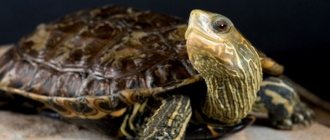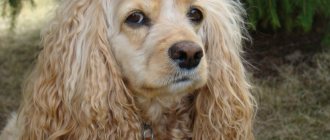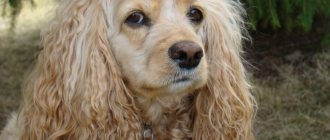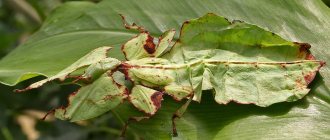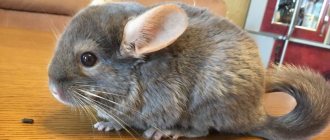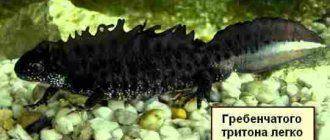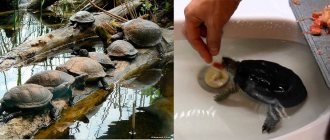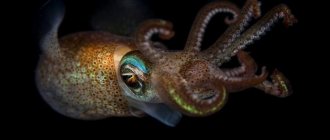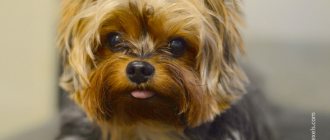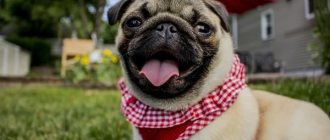Toy terriers originally lived in England. There they were popular with the ladies, because the dog could be taken with you anywhere, thanks to their miniature size. They began to be imported to Russia in the mid-19th century, and they found their fans here too.
After the revolution, many dogs ended up on the street and there was crossbreeding with ordinary dogs, which led to a significant deterioration of the breed.
Appearance
The Russian Toy Terrier is an elegant dog with long straight legs and lean muscles. His neck is elongated and elegant. The tip of the nose, depending on the color of the toy, is brown or black. The ears of such dogs are erect, thin, set high and have the shape of an isosceles triangle with pointed or rounded tips.
Among Russian Toy Terriers there are two variations: smooth-haired and long-haired. The first have: the coat is shiny and short, close to the body, there is no undercoat or bald patches; in the second, the coat is moderately long (3–5 cm), can be somewhat wavy or straight, frames the body without hiding its contours.
The color is usually uneven: on the face, chest and limbs there are spots lighter than the main tone. The color of the coat, as well as its shades, is variable: from fawn to black. The color is rich.
Gender is weakly expressed outwardly, however, it is clearly manifested in the behavioral line.
Necessary things for maintenance
Before purchasing a puppy, prepare the necessary things for your toy terrier:
- Ceramic bowl . This is the best option - it does not emit toxins, it is durable.
- Massage brush with a long handle . Convenient for brushing a nimble puppy.
- Shampoo . It is better to purchase a special one for short-haired breeds.
- Ear cleaning liquid . It is not possible to buy a special lotion; use wet wipes or a solution of hydrogen peroxide.
- Latex toothbrush . Eliminates plaque.
- Meat flavored toothpaste . Brushing your teeth will eliminate the formation of tartar.
- Rubber toys . Chewing hard rubber builds strong jaws.
If you decide not to take your toy outside, purchase a tray for him. Tweezers for pulling out long hairs from the auricle won't hurt either. When they die, they enter the ear canal and cause discomfort to the dog.
Character
Dogs of this breed are surprisingly dynamic and playful. They are friendly and get along well with others, including other pets. They are especially loving towards their owners and are also extremely loyal to them.
The psyche of Russian toy terriers is labile - they are very emotional dogs that “take everything to heart.” There is a danger of stress. In this regard, the animal should not be scolded, left alone, and it is advisable to exclude loud sounds that may frighten it.
Toy terriers are excellent for home keeping. For kids, the dog will be an ideal play companion; will give elderly and lonely people all the overwhelming affection and warmth, brightening up the gray days.
Appearance
Small size, good health, stable psyche, unpretentiousness (compared to other miniature breeds) and loyal disposition are the optimal qualities for an apartment companion. Physically, Toy Terriers are weak and thin-boned, but agile, courageous and harmonious in build. Bitches are slightly larger than males (this is a common practice for small dogs), and the restrictions prescribed by the standard are common to both sexes:
- Height 20–28 cm.
- Weight up to 3 kg.
Caring for the Russian Toy
Dogs of this breed are unpretentious in maintenance. These are not the big dogs that need to be walked several times a day. The toy is great at learning to go to a regular cat litter box when needed. However, walking cannot be completely ruled out. A small terrier needs periodic outings into nature and fresh air for its psychophysical health.
This dog does not require frequent bathing, only once a month. During water procedures, it is worth inserting cotton wool into your ears to prevent water from flowing into them. In addition, your ears should be checked for infections from time to time. Also, as necessary, the toy's claws are trimmed.
Caring for the coat of the long-haired variety comes down to daily combing with a fine-toothed comb - a pleasant procedure for both the pet and its owner. Although a terrier is considered a tame dog, you shouldn’t carry it in your arms or in a bag all the time, it needs a burst of bursting energy.
Reproduction and lifespan
Before you start breeding a pet, you should pay attention to the following factors:
- Wool length. Short-haired representatives should not be crossed with long-haired ones.
- The dog's weight must be at least 1.5 kg, with a height of 20 cm or more. Less than this indicator, the dog is not suitable for mating, as it is not able to bear healthy offspring.
- Pet class. Pet class is not used for breeding.
The wrong choice of a partner can lead to the appearance of sickly offspring with many pathologies.
The first mating of a bitch can occur after the 3rd heat. From one to three puppies can be born at a time. The relationship between the ages of humans and pets is shown in the table.
| Dog age | Person's age |
| 1 year | 15 years |
| 3 years | 28 years |
| 5 years | 36 years |
| 7 years | 44 years old |
| 9 years | 52 years old |
| 10 years | 56 years old |
| 12 years | 64 years old |
Feeding
Despite the fact that the Russian Toy Terrier is a miniature dog and does not need large portions of food, its diet must still contain all the necessary nutrients and minerals.
Adult dogs
Feeding rules:
- main meals: twice a day - in the morning and after an evening walk;
- It is allowed to pamper your pet with a treat in the middle of the day (dog biscuit, leather bone);
- calculation of the daily diet: 50–80 grams of food per 1 kg of animal weight;
- when calculating daily feeding, the dog’s lifestyle is taken into account: older and inactive people require less food than young and active people or pregnant women;
- food should be at room temperature;
- The water is certainly raw, but filtered.
Daily diet:
- meat: lamb, veal, raw beef;
- poultry: boiled turkey and chicken (boneless);
- sea fish - boiled fillet;
- porridge: oatmeal, buckwheat, rice (with water);
- fermented milk products: low-fat cottage cheese, kefir, fermented baked milk;
- vegetables (carrots are required) - fresh (grated on a fine grater), stewed, boiled (without salt);
- fruits: bananas and apples are especially useful.
Weekly (no more than once):
Boiled eggs;
- offal: heart, kidneys, liver;
- corn porridge.
Contraindicated products:
- milk;
- sausage (any);
- smoked products;
- pork;
- nuts;
- legumes;
- sweets;
- bell pepper
If you prefer to feed your pet dry food, you will find the necessary instructions for this on the package. There is no universal guide for dry food, since different manufacturers have different compositions of nutrients included in them.
High-end ready-made food is produced by: Hills, Royal Canin, Orijen, Canidae, Eagle Pack. Please note that these companies produce food specifically for small dogs, some even by breed, as indicated on the packaging.
Puppies
Naturally, from the moment they are born, babies are fed exclusively with mother's milk. After three weeks, without removing the mother from the breast, small complementary foods are introduced. Additional food in the form of beef and low-fat cottage cheese is given in small peas - always warmed to room temperature - 3 times a day.
Menu from 6 to 8 weeks (feeding every 4 hours):
- 1 feeding: a ball of raw meat;
- 2 feeding: cottage cheese diluted with milk or kefir;
- 3 feeding: cottage cheese again;
- 4 feeding: porridge boiled in water - rice, oatmeal or buckwheat;
- 5 feeding: milk porridge;
- 6 feeding: a pea of raw meat.
It is best for puppies to eat meat from the menu listed above, however, you should not exceed the recommended daily portion. There is a significant risk that she will continue to prefer only meat. Ignoring other foods will have a bad effect on his health and overall well-being.
The diet from two to five months remains the same, supplemented with vegetables and fruits. Meals are reduced to four times a day.
From five months, the feeding schedule is adjusted to three meals a day, and after nine months - to two meals a day, with the transition to the diet of adults.
It is extremely important to ensure that the baby receives the food it needs in full. Otherwise, this is fraught with improper development of the musculoskeletal system. This can be tracked quite simply: the puppy must be periodically felt - the ribs should not be noticeable, but they should be felt. If you deviate from this condition, you need to adjust the power supply, depending on which direction the slope goes.
Disease susceptibility
Toy terriers are susceptible to diseases such as:
- enteritis;
- plague;
- rabies;
- hepatitis;
- conjunctivitis;
- allergy;
- leptospirosis.
Expert opinion
Anna Abramenko
An avid dog lover. Experience in veterinary medicine since 2009.
Ask a Question
If you suspect the development of one of these diseases, your dog requires immediate veterinary attention.
Upbringing
Despite their diminutive size, they are still terriers, and they have a rather serious character with a bright temperament. Toys are perfectly trainable and if aggression is noticed in a puppy, it should be sent for re-education. This will help avoid problems with aggression in the future. However, “characteristic” toys are a rarity; most of them are cute and cheerful dogs.
It is important to remember that a “lap” dog is not a cat that walks on its own, nor is it a toy. She has her own needs, characteristics and instincts. If this is neglected, then the risk of developing “small dog syndrome” or “Napoleon complex” increases in the toy terrier. At the same time, the dog will become uncontrollable: he will consider himself the main one in the house, bark at everything that does not suit him, and rush at others.
To avoid excessive self-will, you must strictly follow a number of rules:
- do not allow him to aggressively jump on people;
- do not allow barking and growling whenever you want;
- make sure that the dog does not climb onto your lap on its own;
- prohibit sleeping on the owner's pillow.
How to choose a puppy
You need to choose a four-legged friend at the age of 2.5-3 months. The approximate weight of the individual in question will be 1.5 kg.
If the puppy’s weight by the age of 2.5-3 months hardly exceeds 600 g, there is a high risk of acquiring a dwarf or defective individual.
The pedigree deserves special attention. This is especially true for situations in which the purchase of a pet category dog is being considered.
Reasons why it is better not to buy a dog from a breeder:
- Lack of veterinary passport.
- Excessively bulging eyes.
- Puppies are kept in cages and are not released for inspection.
- Strabismus.
- Discharge around the nose and eyes.
- Bald spots.
Changing baby teeth
The Russian Toy Terrier, despite its miniature size, has the same set of teeth as the Caucasian Shepherd Dog - 42 pieces. Of these, 22 are located on the lower jaw and 20 on the upper jaw. They include 4 types of teeth: incisors, canines, molars and premolars.
Although it is important for toy terriers intended for exhibitions to have all their teeth, they are not disqualified due to the absence of molars. In addition, such dogs are allowed for mating.
Toys are born with absolutely no teeth. The first primary canines erupt on days 12–16 of life. Then, on each jaw another 6 premolars and 6 incisors are shown. The number of primary premolars is exactly this due to the fact that at this age the first tooth is still missing. By two months, approximately 28 baby teeth have formed in the toy's mouth.
The replacement of baby teeth with molars begins at the age of four months or six months and continues until eight months. The incisors are replaced first. Under the roots of the deciduous teeth, the rudiments of the molar incisors are born, during which the roots of the first ones dissolve and become shaky. Then the baby teeth fall out on their own.
In show Russian Toy Terriers, by the age of eight months, absolutely all their teeth should have changed. If this does not happen, you should be wary. Due to the fact that the molars grow along the same canals as the milk teeth, failure of the latter to fall out may result in a lack of growth or curvature of the former.
During the period when puppies are changing their teeth, you need to carefully monitor their health. In weakened dogs, this process may be delayed or extended over time. Make sure you have enough vitamins and protection from hypothermia.
If a baby tooth does not fall out on time, you can try to help the baby on your own. To do this, gently shake the tooth that is about to fall out. The degree of unsteadiness will increase and eventually it will fall out. If you can’t cope on your own, you need to take the puppy to a veterinary clinic. There he will be helped in this matter with the use of anesthesia or anesthesia.
Training
Toy terriers are taught order from an early age. The dog should not beg for treats, go to the toilet in the wrong place and bark for no reason. The puppy is clearly shown what is required of him, and the result is reinforced with a treat. An adult Toy is trained differently: he is scolded for unfulfilled commands and praised for his successes.
Dogs should not be trained by shouting and punishment. They will hold a grudge and will not respond to orders.
In addition, it is useful to teach toys standard commands: fu, come to me, next to me, sit, lie down. To prevent your pet from showing aggression towards other people's dogs and people, it needs to be socialized in time. It is best to start this process after the first vaccinations.
Health
With high-quality maintenance of Russian Toys, they practically do not get sick.
It is important to ensure that the dog does not fall. In particular, you should not take risks by lifting it onto objects whose surface is higher than 40 cm from the floor. It is also necessary to control the toy's contacts with large dogs. In both cases, the injury may be caused by the inability of terrier dogs to balance their size and strength with their desires. These dogs simply do not feel their small size (especially cables).
When a dog comes into contact with a very small child, it is necessary to closely monitor their games. A baby who does not yet know how to coordinate his movements and control strength can accidentally cause serious injury to the dog.
Do not buy a Russian Toy Terrier puppy on the market, there is a high probability that the dog will be nervous and sickly. To be absolutely sure of your dog’s psychophysical health, contact only trusted breeders.
Organs most susceptible to diseases:
- teeth;
- skeletal system;
- skin covering;
- pancreas;
- heart muscle.
Basic moments
Breed characteristics:
- Excellent memory
- Lack of aggression
- Innate protective qualities
- Due to their small size they feel good in small apartments
- Not bad for training
The Toy Terrier is a naturally stubborn species that needs to be approached. He does not accept the authoritarian style. In the process of subsequent training, any psychological pressure should be excluded.
Professionally presses for pity, gradually studying the owner. Able to make friends with other pets.
Any sharp sound will be accompanied by a piercing bark. You should start training your toy terrier as early as possible.
Toys have low stress resistance, which is why they are not recommended for families with small children.
Colors
Standard colors of the Russian Toy:
- black and tan;
- brown and tan;
- blue and tan;
- lilac and tan;
- ginger;
- red with black;
- red with brown;
- red and blue;
- red with lilac;
- fawn (lightened dogs with a black or asphalt nose);
- cream (bleached dogs with brown or purple noses).
Undesirable, but acceptable:
- black,
- brown,
- blue,
- lilac,
- zonal,
- black-and-white
Absolutely unacceptable with the mark “non-standard color” (nevertheless, healthy dogs of the Russian Toy breed with such a mark can, without participating in breeding and exhibitions, become excellent pets):
- any colors with brindles,
- marble,
- piebald,
- spotted,
- white.
Learning ability
It is quite easy to learn. The most common mistake that owners of this breed make when raising them is the desire to isolate the dog in an apartment. With such content, they will be completely deprived of the joy of communicating with the outside world, other people and animals. Of course, normal formation of the dog’s psyche is impossible in this case.
The absence of aggression towards strangers makes it possible to normally help decorative dogs in such sometimes difficult procedures as mating and childbirth. A calm attitude towards attention to oneself is extremely necessary for dogs who are going to attend exhibitions. After all, there inevitably completely strangers will climb into the dog’s mouth and feel various parts of the body. Toy can be taught many tricks: dancing, “singing” to music, tumbling. And the dog may like all this.
